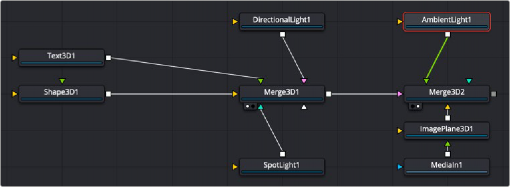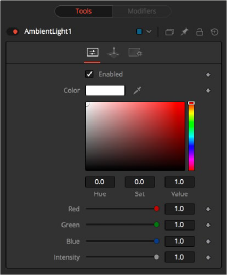
< Previous | Contents | Next >

The Ambient Light node
Ambient Light Node Introduction
An Ambient Light is a directionless light that globally illuminates a scene. It has no real position or rotation, although an onscreen control appears in the viewer to indicate that a light is present in the scene. Position controls for the viewer are provided to move the widget out of the way of other geometry, if necessary.
Similar to a Camera 3D, you connect lights into a Merge 3D and view them in the scene by viewing the Merge 3D node. Selecting a light node and loading it into the viewer does not show anything.
Inputs
The Ambient Light node includes a single optional orange input for a 3D scene or 3D geometry.
— SceneInput: The orange input is an optional input that accepts a 3D scene. If a scene is provided, the Transform controls in this node apply to the entire scene provided.
Basic Node Setup
![]()
The Ambient Light node is designed to be part of a larger 3D scene. You connect the light directly into a Merge 3D. Separating lights into different Merge 3D nodes allows you to control which lights affect which objects.

Ambient Light node structure
Inspector

Ambient Light controls
Controls Tab
The Controls tab is used to set the color and brightness of the ambient light.
When the Enabled checkbox is turned on, the ambient light affects the scene. When the checkbox to turned off, the light is turned off. This checkbox performs the same function as the red switch to the left of the node’s name in the Inspector.
![]()
Use this standard Color control to set the color of the light.
Use this slider to set the Intensity of the ambient light. A value of 0.2 indicates 20% percent light. A perfectly white texture lit only with a 0.2 ambient light would render at 20% gray (.2, .2, .2).
Common Controls
The options presented in the Transform and Settings tabs are commonly found in other lighting nodes. For more detail on the controls found in these tabs, see “The Common Controls” section at the end of this chapter.